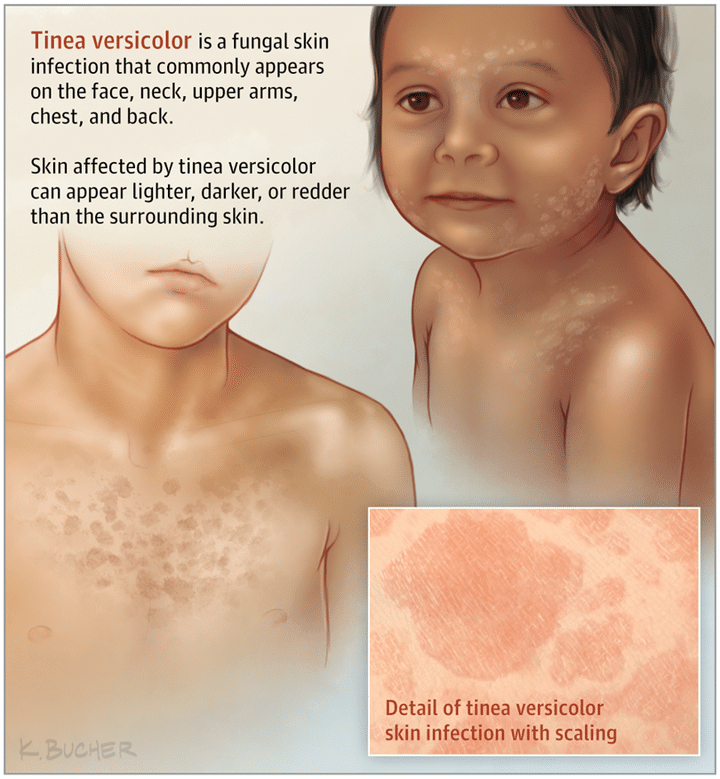Tinea Versicolor - Know More About It!
Tinea Versicolor -
Tinea versicolor also called pityriasis Versicolor is an infection of the human body caused by the Malassezia fungus, which is normally found on the human skin. Normally, this fungus does not harm the body and even protects our skin from infections or diseases. But at times, it grows rapidly and changes the skin colour, resulting in the tinea versicolor disease.
Tinea versicolor does not cause any kind of critical harm to the health or pain in your body. However, those are more of the cosmetic concerns for its patients. The disease causes small white or other colored patches of light to dark shades in smaller to larger areas on the skin. It primarily takes place in the upper back, chest, and shoulders of an individual.
However, it may impact almost any part of the body. So, if such marks are well visible on your body even on covering up with the getups, you may feel a little awkward to go out in public. This disease generally affects young adults and teens. Other than that, the individuals residing in humid and warm weather are more likely to suffer from tinea versicolor.
Symptoms of Tinea Versicolor:
Following are the various general symptoms of the tinea versicolor disease:
- Light to dark skin discoloration patches mainly on the chest, back, neck, upper half areas of the arms, and other areas on the body
- The patches may be of red, pink, brown, or tan colours
- The short-period or continual growth of such patches for few months
- Scaling
- Mild to intense itching in the skin area on which such patches are seen
Normally, tinea versicolor does not cause any harm to your skin or body, just apart from the itchy temptation. Additionally, you may feel sensitivity, uneasiness and irritation in the impacted area at times. Rest than that, young and healthy people are more likely to have tinea versicolor on their skin as compare to the people of other age groups.
Note that once such marks appear on any part of the body of its patient, those may be disappeared in the cold season, and intensify again in the summer season. Those may also subside in case you shift to a cold place during the summer season also. So, it is more of a seasonal or climatic disease for its patients.
Causes of Tinea Versicolor
As already mentioned, the primary cause of the tinea versicolor is the Malassezia class of fungus, found on the skin of a healthy person. However, the symptoms of tinea versicolor are seen only with their overgrowth. Following are the primary reasons that trigger the growth of the Malassezia fungus and consequently causes tinea versicolor:
- Humid and hot weather, this fungus could not breed easily in the cold weather
- Individuals with oily skin
- Hormonal changes in the body of healthy people
- Individuals with weaker immunity
- Individuals who observe more sweating than usual
Prevention of Tinea Versicolor
Since the Malassezia fungus is always there on the human skin, it is very difficult to completely prevent the occurrence of tinea versicolor. But in case you are once diagnosed with it and have got complete treatment, you may take several measures to prevent its recurrence in the future.
Some of those are mentioned below:
- Avoid exposure to excessive heat, which may cause you to sweat more
- Refrain from direct exposure to the sunlight for several hours at a stretch
- Prevent your body from tanning due to sunlight by applying sunscreen lotion on your body before going out
- Avoid excessive sweating for any reason
- Use a Selenium-based antidandruff shampoo at least once in every few weeks
- Avoid wearing tight clothes in the summer seasons
- Try to wear cotton clothes for decreasing sweat
- Adopt a well-balanced and healthy diet rich with vitamins, minerals, and fiber, to keep your immune system intact
- Avoid eating too much junk food
Take note that there are several patients who tend to suffer from tinea versicolor during a specific set of months of every year, like from May to August. They may prevent its reoccurrence by adopting some skin strengthening treatment using the following medicines:
- Selsun or selenium sulphide, 2.5% lotion
- Ketoconazole, Ketoconazole or Nizoral gel or cream
- Onmel and Sporanox (Itraconazole) capsules or tablets
- Diflucan (Fluconazole) tablets
Diagnosed with Tinea Versicolor?
Normally, you are not required to worry about the treatment for tinea versicolor, being a lesser harmful disease. But, in case you see any of the symptoms associated with it on any part of your body, you may consult your doctor. Post a visual examination of the symptoms, the doctor may confirm the occurrence of tinea versicolor.
If required, the dermatologist may recommend performing a test in which some skin sample is extracted from the infected area and sent to the laboratory for the microscopic examination. A good amount of the Malassezia fungus in the skin sample confirms the tinea versicolor disease in the infected part of the body.
Treatment of Tinea Versicolor
Post the diagnosis and confirmation of tinea versicolor, the dermatologist may recommend you the medical treatment for stopping the growth of the Malassezia fungus in your skin. This may be required only in cases when the symptoms are severe. This treatment would also help you in avoiding the disease’s symptoms for the long-term.
Some of the medicines that help in coping-up with the symptoms of this disease include the following types of antifungal shampoos or creams:
- Clotrimazole - Lotrimin AF and Mycelex
- Selenium Sulfide - Selsun Blue shampoo
- Miconazole - Monistat and M-Zole
- Terbinafine - Lamisil
The following creams or ointments may be applied locally on the skin area affected with tinea versicolor to kill the fungus:
- Ketoconazole - Extina and Nizoral
- Ciclopirox – Loprox and Penlac
Note: It is recommended to wash and dry the infected area before applying these creams or ointment over those. The doctor may prescribe to apply those as a thin layer at least twice a day for at least one to two weeks.
The dermatologist may also prescribe you the following pills or capsules for the treatment of tinea versicolor:
- Itraconazole – Onmel and Sporanox
- Fluconazole - Diflucan
- Ketoconazole
Other than the dermatology treatment, there are certain home remedies that you may adopt for the treatment of this disease. Although all such home remedies are natural and hence safer to adopt, it is strongly recommended to discuss with your doctor before starting over those. There are certain conditions like pregnancy or other illnesses, in which these ingredients may cause harm to the body.
The doctor will diagnose your physical conditions and symptoms to ensure that any of those would not cause any harmful side impact on your body. Some of such home remedies may include consumption and/or application of the following substances on the impacted area of tinea versicolor:
- Garlic
- Turmeric
- Apple cider vinegar
- Indian lilac
- Yoghurt
Complications with Tinea Versicolor
There have not been found any cases where tinea versicolor would have caused severe complications on the skin or any other part of the body. For this reason, you may leave it untreated even for a long time from its diagnosis. The only bad part is that many of its patients do not like its appearance of their bodies.
The primary, but mild, a complication of this disease is the discoloration of the skin. This may persist for even several weeks after starting the treatment, since the skin colour producing cells (known as melanocytes) may take that much of time for complete recovery and pigmentation. Note that this disease never imposes any permanent complication on your skin.
The symptoms are even vanished or minimized in the winter season or at colder places. Since the infection or discolouration occurs only on the surface of the skin, there is no impact on the body organs or the immune system of the patient of this disease.
Other than the weird or different coloured appearance, few patients in some rare cases may observe the enlarged size of tineas on their body. It makes them face problems wearing fitted clothes, shoes and more.
Myths related to Tinea Versicolor
Myth #1: Tinea versicolor, if not treated on time, may become a cause of skin cancer
Although the symptoms may look little alike, tinea versicolor is different from that of skin cancer. Tinea versicolor is the overgrowth of a specific type of fungus on the skin. However, skin cancer is an overgrowth of the skin tissues itself, which is unstoppable. In case the symptoms on your skins are worsening over time, it would be good to see a dermatologist at the earliest. If the physicians suspect that the discoloration or patches on the patient’s skin are due to skin cancer, they may advise getting a biopsy test done.
Myth #2: Sitting in the sunlight would help in reducing the size and growth of tinea versicolor
Sunlight would not reduce the existing impact or stop the growth of tinea versicolor. On the other hand, the sunlight would tan the affected area and highlight it. Other than that, the sunlight would give an ample amount of heat to the fungus, which would be ideal for them to breed. So, sunlight will ultimately worsen the symptoms of tinea versicolor.
Myth #3: Once after completion of the treatment, tinea versicolor would not reoccur
This is not true. A person once affected by tinea versicolor is, in fact, more prone to catch the infection again in the hotter climate conditions. It is therefore recommended for them to take the most care and follow the precautions, especially during the summer season.
Myth #4: Only the individuals with a weaker immune system may be affected by tinea versicolor
It is true that individuals with a weaker immune system are more likely to catch an infection of tinea versicolor. However, there are multiple other reasons that tend to increase the risk associated with this disease. For instance, healthy people undergoing hormonal changes may also suffer from this disease easily.
Myth #5: Individuals with fairer skin are more prone to get affected by tinea versicolor as compared to those with light skin
Individuals with any colour of skin are equally likely to develop this disease considering the other affecting conditions and factors. There is nothing specific for this disease related to skin colour.
Conclusion
Tinea versicolor is just the state of mild skin infection caused due to overgrowth of the Malassezia class of fungus on the patient’s skin. It does not have adverse symptoms on the skin, which also do not impose any direct health complication.
However, you must visit a dermatologist if the symptoms are not stopping over several months, for the confirmation that it is not skin cancer. Once diagnosed, you may get it treated by the doctor for the disappearance of the symptoms. You should also follow the precautions mentioned in this article to avoid this disease to take place.
Update From Lybrate: Keeping your skin healthy is very important, therefore, we suggest you choose the Skin Care Products according to your skin type requirements and usages at Lybrate.



+1.svg)
